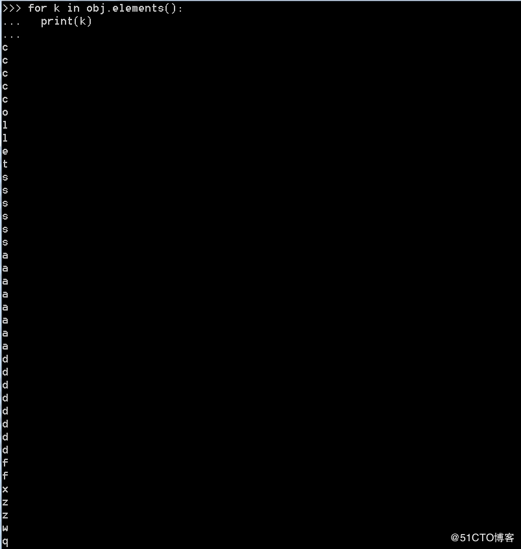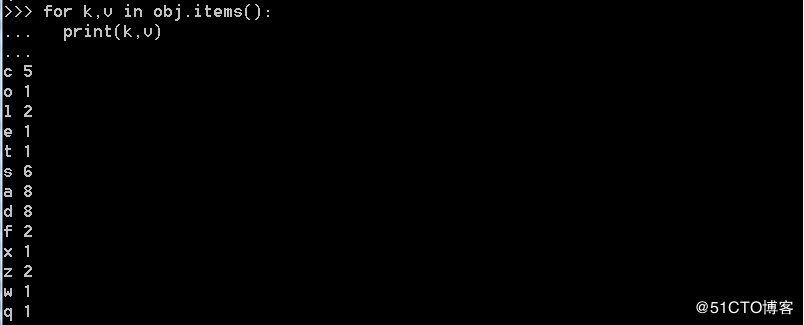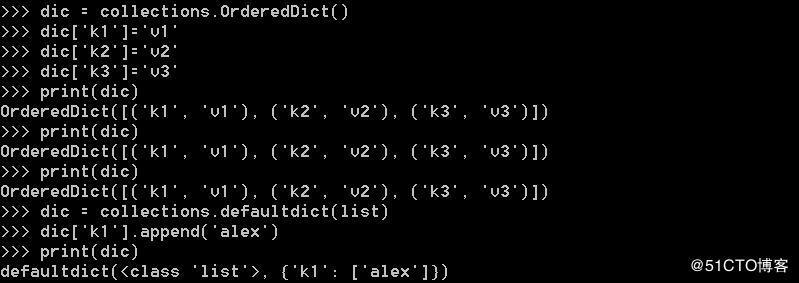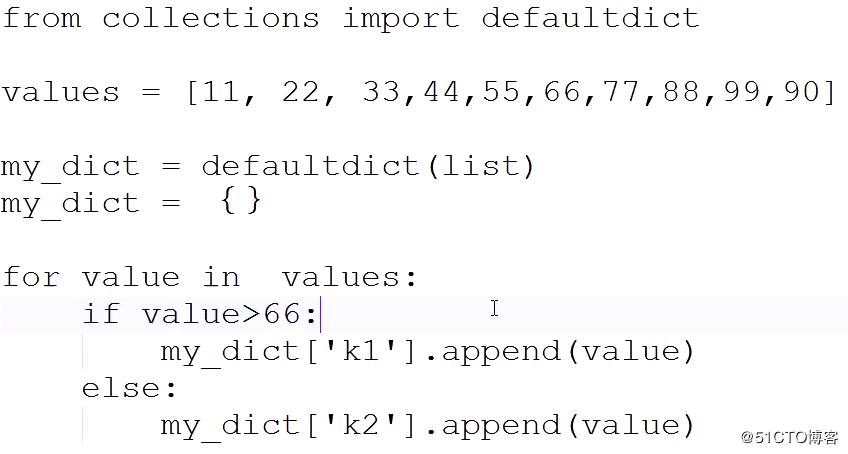Python随笔(三)、python基础
发布时间:2019-09-03 08:53:45编辑:auto阅读(2182)
一、练习:
#!usr/bin/env python
#-*- coding:utf-8 _*-
"""
@author:Administrator
@file: dictionary.py
@time: 2017/11/19
"""
'''
有如下集合[11,22,33,44,55,66,77,88,99,110,121,132,143,154,165,176,187],将所有大于66的值保存在字典的第一个key中,将小于66的值保存在第二个key的值中
即:{'k1':大于66,'k2':小于66}
'''
######方法一
#dic = {}
#all_list = [11,22,33,44,55,66,77,88,99,110,121,132,143,154,165,176,187]
#for i in all_list:
# if i > 66:
# if "k1" in dic.keys():
# dic["k1"].append(i)
# else:
# dic['k1'] = [i,]
# else:
# if "k2" in dic.keys():
# dic["k2"].append(i)
# else:
# dic['k2'] = [i,]
#print(dic['k1'])
#print(dic['k2'])
#方法二、
all_list = [11,22,33,44,55,66,77,88,99,110,121,132,143,154,165,176,187]
dic = {'k1':[],'k2':[]}
for item in all_list:
if item>66:
dic["k1"].append(item)
else:
dic["k2"].append(item)
print(dic['k1'])
print(dic['k2'])set集合:
#!usr/bin/env python
#-*- coding:utf-8 _*-
"""
@author:Administrator
@file: set.py
@time: 2017/11/20
"""
#爬虫
s1 = set()
s1.add("alex")
print(s1)
s1.add('alex')
print(s1)返回结果:
{'alex'}
{'alex'}
#访问速度快
#天生解决了重复问题
clear
copy
过滤重复功能:
#!usr/bin/env python
#-*- coding:utf-8 _*-
"""
@author:Administrator
@file: set.py
@time: 2017/11/20
"""
#爬虫
s2 = set(["alex","eric","tony","alex"])
print(s2)返回结果:
{'eric', 'alex', 'tony'}
difference
#!usr/bin/env python
#-*- coding:utf-8 _*-
"""
@author:Administrator
@file: set.py
@time: 2017/11/20
"""
#爬虫
s2 = set(["alex","eric","tony","alex"])
print(s2)
s3 = s2.difference(["alex","eric"])
print(s3)返回结果:
{'tony', 'eric', 'alex'}
{'tony'}
difference
difference_update
#!usr/bin/env python
#-*- coding:utf-8 _*-
"""
@author:Administrator
@file: set.py
@time: 2017/11/20
"""
#爬虫
#去除重复的集合
s2 = set(["alex","eric","tony","alex"])
print(s2)
#与s2不相同的部分
s3 = s2.difference(["alex","eric"])
print(s3)
#删除当前set中的所有包含在参数集合里的
s4 = s2.difference_update(["alex","eric"])
print(s4)返回结果:
{'tony', 'eric', 'alex'}
{'tony'}
None
intersection 取交集
isdisjoint 如果没有交集返回true
issubset 是否是子集
issuperset 是否是父集
pop 移除
remove 移除
symmetric_difference_update 差集
union 并集
update 更新
# 数据库中原有old_dict = { "#1":{ 'hostname':c1, 'cpu_count': 2, 'mem_capicity': 80 }, "#2":{ 'hostname':c1, 'cpu_count': 2, 'mem_capicity': 80 } "#3":{ 'hostname':c1, 'cpu_count': 2, 'mem_capicity': 80 }}
# cmdb 新汇报的数据new_dict = { "#1":{ 'hostname':c1, 'cpu_count': 2, 'mem_capicity': 800 }, "#3":{ 'hostname':c1, 'cpu_count': 2, 'mem_capicity': 80 } "#4":{ 'hostname':c2, 'cpu_count': 2, 'mem_capicity': 80 }}
交集:要更新的数据
差集:原来,要更新
1、原来没有 --》 新加入
2、原来有 --》 更新
3、新无,原来有 --》原来删除
三个列表:
要更新的数据
要删除
要添加
#!usr/bin/env python
#-*- coding:utf-8 _*-
"""
@author:Administrator
@file: set.py
@time: 2017/11/20
"""
# 数据库中原有
old_dict = {
"#1":{ 'hostname':"c1", 'cpu_count': 2, 'mem_capicity': 80 },
"#2":{ 'hostname':"c1", 'cpu_count': 2, 'mem_capicity': 80 },
"#3":{ 'hostname':"c1", 'cpu_count': 2, 'mem_capicity': 80 },
}
# cmdb 新汇报的数据
new_dict = {
"#1":{ 'hostname':"c1", 'cpu_count': 2, 'mem_capicity': 800 },
"#3":{ 'hostname':"c1", 'cpu_count': 2, 'mem_capicity': 80 },
"#4":{ 'hostname':"c2", 'cpu_count': 2, 'mem_capicity': 80 },
}
old = set(old_dict.keys())
new = set(new_dict.keys())
#更新的集合
update_set = old.intersection(new)
#删除的集合
delete_set = old.symmetric_difference(new)
#添加的集合
add_set = new.symmetric_difference(update_set)
print(update_set)
print(delete_set)
print(add_set)
print(old)
print(new)
返回结果:
{'#1', '#3'}
{'#2', '#4'}
None
{'#1', '#2', '#3'}
{'#4'}
例子:
#!usr/bin/env python
#-*- coding:utf-8 _*-
"""
@author:Administrator
@file: s1.py
@time: 2017/11/20
"""
s1 = set([11,22,33])
s2 = set([22,44])
ret1 = s1.difference(s2)
ret2 = s1.symmetric_difference(s2)
print(ret1)
print(ret2)返回结果:
{33, 11}
{33, 11, 44}
collections系列
http://www.cnblogs.com/wupeiqi/articles/5115190.html

collections 计数器
most_common 最多的次数
element 所有的元素



orderedDict 有序字典

pop
popitem
setdefault 设置默认值
update 更新原来的数据

默认字典:

可命名元祖:创建类

双向队列(deque)
https://www.cnblogs.com/zhenwei66/p/6598996.html
单向队列(queue),需要导入queue模块
https://www.cnblogs.com/zhenwei66/p/6599136.html
邮件模块:
#!usr/bin/env python
#-*- coding:utf-8 _*-
"""
@author:Administrator
@file: mail.py
@time: 2017/12/19
"""
import smtplib
from email.mime.text import MIMEText
from email.utils import formataddr
def mail():
ret = True
try:
msg = MIMEText('how are you,you are a good men','plain','utf-8')
msg["From"] = formataddr(["陈继松",'chenjisong@wtoip.com'])
msg["To"] = formataddr(["406564728@qq.com",'406564728@qq.com'])
msg['Subject'] = "主题"
server = smtplib.SMTP("smtp.wtoip.com",25)
server.login("chenjisong@wtoip.com","**************")
server.sendmail('chenjisong@wtoip.com',["406564728@qq.com",], msg.as_string())
server.quit()
return ret
except Exception:
ret = False
return ret
ret = mail()
if ret:
print('发送成功')
else:
print('发送失败')默认参数:
def show(a1,a2=999,a3=333,a4=444,a5=555):
print(a1,a2,a3,a4,a5)
show(111,222,333,444,555)指定参数:
def show(a1,a2):
print(a1,a2)
show(a2=33334,a1=555556)
动态参数,个数无限制
def show(**arg):
print(arg,type(arg))
show(a1=123,a2=456,a3=789)
返回结果:
E:\Python36\python.exe C:/Users/Administrator/PycharmProjects/2017-12-10/2017-12-19/s4.py
{'a1': 123, 'a2': 456, 'a3': 789} <class 'dict'>
动态参数(强强联合):
def show(*args,**kwargs):
print(args,type(args))
print(kwargs,type(kwargs))
show(11,222,33,44,n1=88,alex="sb")
返回结果:
E:\Python36\python.exe C:/Users/Administrator/PycharmProjects/2017-12-10/2017-12-19/s4.py
(11, 222, 33, 44) <class 'tuple'>
{'n1': 88, 'alex': 'sb'} <class 'dict'>
def show(*args,**kwargs):
print(args,type(args))
print(kwargs,type(kwargs))
l = [11,22,33,44]
d = {'n1':88,'alex':'sb'}
show(l,d)
返回结果:
E:\Python36\python.exe C:/Users/Administrator/PycharmProjects/2017-12-10/2017-12-19/s4.py
([11, 22, 33, 44], {'n1': 88, 'alex': 'sb'}) <class 'tuple'>
{} <class 'dict'>
如果我想把l放入列表里面,把d放入字典里面,则:
def show(*args,**kwargs):
print(args,type(args))
print(kwargs,type(kwargs))
l = [11,22,33,44]
d = {'n1':88,'alex':'sb'}
show(*l,**d)
返回结果:
E:\Python36\python.exe C:/Users/Administrator/PycharmProjects/2017-12-10/2017-12-19/s4.py
(11, 22, 33, 44) <class 'tuple'>
{'n1': 88, 'alex': 'sb'} <class 'dict'>
22 python s12 day3 使用动态参数实现字符串格式化
1、
alex = sb的三种方式:
s1 = "{name} is {acter}"
d = {'name':'alex','acter':'sb'}
#result = s1.format(name='alex',acter='sb')
result = s1.format(**d)
print(result)
返回结果:
E:\Python36\python.exe C:/Users/Administrator/PycharmProjects/2017-12-10/2017-12-19/s4.py
alex is sb
2、字符串格式化
s1 = "{name} is {acter}"
result = s1.format(name='alex',acter='sb')
print(result)
返回结果:
E:\Python36\python.exe C:/Users/Administrator/PycharmProjects/2017-12-10/2017-12-19/s4.py
alex is sb
3、
s1 = "{0} is {1}"
l = ['alex','sb']
result = s1.format('alex','sb')
result = s1.format(*l)
print(result)
返回结果:
E:\Python36\python.exe C:/Users/Administrator/PycharmProjects/2017-12-10/2017-12-19/s4.py
alex is sb
23 python s12 day3 Python lambda表达式
def func(a):
a +=1
return a
result = func(4)
print(result)
返回结果:
E:\Python36\python.exe C:/Users/Administrator/PycharmProjects/2017-12-10/2017-12-19/s4.py
5
lambda表达式,简单函数的表示方式:
func = lambda a: a+1
#创建形式参数a
#函数内容a+1,并把结果return
ret = func(99)
print(ret)
返回结果:
E:\Python36\python.exe C:/Users/Administrator/PycharmProjects/2017-12-10/2017-12-19/s4.py
100
24、内置函数:
#绝对值:
a = -100
b = a.__abs__()
print(b)
返回结果:
E:\Python36\python.exe C:/Users/Administrator/PycharmProjects/2017-12-10/2017-12-19/s4.py
100
更多详见:http://www.runoob.com/python/python-built-in-functions.html
map的巧用:
li = [11,22,33,44]
new_li = map(lambda x:x+100,li)
l = list(new_li)
print(l)
返回结果:
E:\Python36\python.exe C:/Users/Administrator/PycharmProjects/2017-12-10/2017-12-19/s4.py
[111, 122, 133, 144]
上一篇: Python图像库-Python Ima
下一篇: Java知识:(3)Tomcat
- openvpn linux客户端使用
51333
- H3C基本命令大全
50787
- openvpn windows客户端使用
41380
- H3C IRF原理及 配置
38183
- Python exit()函数
32672
- openvpn mac客户端使用
29565
- python全系列官方中文文档
28404
- python 获取网卡实时流量
23280
- 1.常用turtle功能函数
23245
- python 获取Linux和Windows硬件信息
21570
- Python搭建一个RAG系统(分片/检索/召回/重排序/生成)
1652°
- Browser-use:智能浏览器自动化(Web-Agent)
2381°
- 使用 LangChain 实现本地 Agent
1987°
- 使用 LangChain 构建本地 RAG 应用
1927°
- 使用LLaMA-Factory微调大模型的function calling能力
2255°
- 复现一个简单Agent系统
1959°
- LLaMA Factory-Lora微调实现声控语音多轮问答对话-1
2656°
- LLaMA Factory微调后的模型合并导出和部署-4
4456°
- LLaMA Factory微调模型的各种参数怎么设置-3
4283°
- LLaMA Factory构建高质量数据集-2
3053°
- 姓名:Run
- 职业:谜
- 邮箱:383697894@qq.com
- 定位:上海 · 松江
